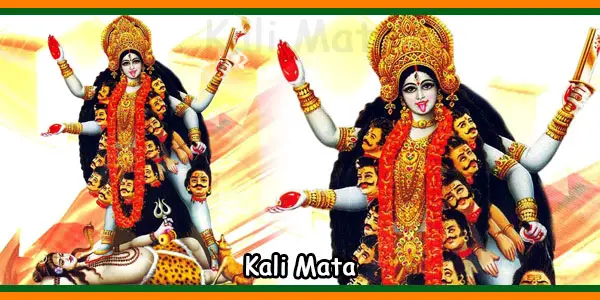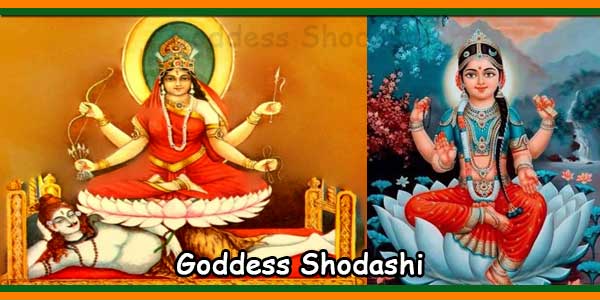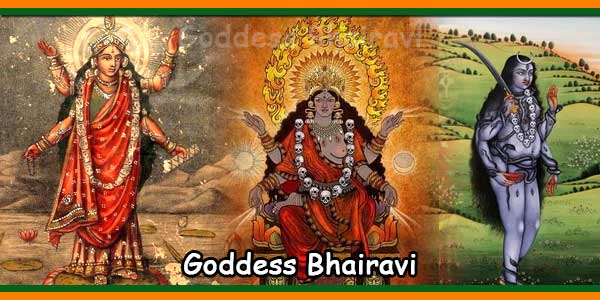The 10 Forms of Goddess Shakti:
1) Goddess Kali
2) Goddess Tara
3) Goddess Shodashi
4) Goddess Bhuvaneshvari
5) Goddess Bhairavi
6) Goddess Chhinnamasta
7) Goddess Dhumavati
6) Goddess Bagalamukhi
9) Goddess Matangi
10) Goddess Kamala
Our ancient texts mention about ten Mahavidya who are worshipped to seek all sorts of powers. Mahavidya worship is known as Sadhana in which worshipper concentrate on a single Goddess to please and to seek Her blessings. In any Sadhana, Yantra and Mantra are considered very effective mediums through which worshippers can reach his target and fulfil his motive to perform it.
In Hinduism, specific Yantra and Mantra are assigned to each deity and those are used as medium to reach the deity to fulfill the motive. Each Goddess along with her Yantra is worshipped through fixed procedure, steps and rituals.
1) Goddess Kali:

Kali is the first of the Das Mahavidya and the fiercest aspect of Goddess Durga. Kali is considered as the Goddess of time and change. She presides over the time before the creation of the universe. Kali is represented as the consort of Lord Shiva. Her abode is cremation grounds and her weapons are Kripana (Scimitar) and Trishul (Trident).
Kali Origin:- As per Devi Mahatmya, Devi Kali was appeared out of Goddess Durga to defeat the demon Raktabija. Raktabija, which means blood-seed, was able to clone himself out of the dripped blood on the ground. When during battle, Raktabija became impossible to kill Goddess Kali appeared to swallow the blood of Raktabija before it dripped to the ground.
Kali Iconography:- Kali is represented as standing in the battleground with one of her feet on the chest of supine Lord Shiva. Her tongue hangs out of her mouth in astonishment for putting her leg on the chest of Lord Shiva. Her complexion is dark and her facial expressions are ferocious. She is depicted with four hands.
In one of the upper hands she holds bloody Kripana and in the other upper hand she holds severed head of a demon. In one of the lower hands she holds a bowel in which she collects blood which drips from demon’s severed head in upper hand. The second lower hand is shown in Varad Mudra. She is depicted nude and wears a garland which is made of human skulls or severed heads. In lower body she wears girdle made of severed human arms.
In some representations, one of the upper hands of Kali is shown in Varada Mudra and one of the lower hands holds a Trishul.
Kali Sadhana: Kali Sadhana is done to conquer over enemies. Kali Sadhana helps to defeat and make enemies powerless. Kali Sadhana is also performed to destroy diseases, to get rid of wicked spirits, wicked planets, fear of sudden death and to gain poetic skills.
Kali Mool Mantra:
ॐ क्रीं क्रीं क्रीं हूँ हूँ ह्रीं ह्रीं दक्षिणे कालिका
क्रीं क्रीं क्रीं हूँ हूँ ह्रीं ह्रीं स्वाहा॥
Kreem Kreem Kreem Hum Hum Hreem Hreem Dakshine Kalika
Kreem Kreem Kreem Hum Hum Hreem Hreem Svaha॥
2) Goddess Tara:

Goddess Tara is the second of the Das Mahavidya. Tara, which means star, is seen as a beautiful but perpetually self-combusting. Hence Goddess Tara is perceived as the personification of unquenchable hunger that propels the life.
Tara is the Goddess who offers ultimate knowledge and gives salvation and also known as Neel Saraswati. Her weapons are Khadga, Sword and pair of scissor.
Tara Origin:- During the churning of the milky sea when poison came out the ocean, Lord Shiva drank it to save the world from destruction. But Lord Shiva fell unconscious under the powerful effect of the poison. At this point Goddess Durga appeared as Tara and took Shiva on her lap and breast fed Him to counteract the effect of the poison. Hence Tara is said to be more approachable to the devotees because of Her maternal instincts.
Tara Iconography:- Goddess Tara is very much similar to Kali in appearance. Both are shown as standing upon a supine Lord Shiva with protruding tongue. However while Kali is described as black, Tara is portrait as blue. Both wear a necklace of severed human head. However, Tara wears a tiger-skin skirt while Kali wears only a girdle of severed human arms. Both have a lolling tongue and blood oozes from their mouths.
Goddess Tara, unlike Goddess Kali, holds a lotus in one of the above arms and a pair of scissors in one of the lower arms. In remaining two arms Goddess Tara holds bloody Kripana and Kapala (skull-cup) filled with the blood.
Tara Sadhana: Devi Tara Sadhana is done to achieve sudden gain of wealth and prosperity. Tara Sadhana sprouts seed of wisdom and knowledge in the heart of the worshipper.
Tara Mool Mantra:
ॐ ह्रीं स्त्रीं हुं फट्॥
Om Hreem Streem Hum Phat॥
3) Goddess Shodashi | Tripura Sundari | Lalita:

Goddess Shodashi is also known as Tripura Sundari. As the name suggests Goddess Shodashi is the most beautiful in all three worlds. In Mahavidya, She represents Goddess Parvati or also known as Tantric Parvati.
Goddess Shodashi is also known as Lalita and Rajarajeshwari which means “the one who plays” and “queen of queens” respectively.
Shodashi Origin:- As Shodashi, Tripura Sundari is represented as a sixteen year old girl. She is believed to embody sixteen types of desires. Mantra to worship Goddess Shodashi also consists of sixteen syllables. Tripura Sundari is also worshipped as the Shri Yantra.
Shodashi Iconography:- Tripura Sundari is described as being dusky, red or golden in complexion and in union with Lord Shiva. The couple is portrayed on a bed, a throne or a pedestal that is upheld by Brahma, Vishnu, Rudra, Ishana and Sadashiva forming the plank.
Goddess Shodashi has a third eye on the forehead. She is clad in red costume and richly bejeweled. She sits on a lotus seat laid on a golden throne. She is shown with four arms in which she holds five arrows of flowers, a noose, a goad and sugarcane as a bow. The noose represents attachment, the goad represents repulsion, the sugarcane bow represents the mind and the arrows are the five sense objects.
Shodashi Sadhana: Shodashi Sadhana is done for pleasure as well as for liberation. Tripura Sundari Sadhana provides strength to control body, mind and emotions.
Shodashi Sadhana is also done for family pleasure, favorable life partner and potency.
Shodashi Mool Mantra:
ॐ ऐं ह्रीं श्रीं त्रिपुर सुंदरीयै नमः॥
Om Aim Hreem Shreem Tripur Sundariyai Namah॥
4) Goddess Bhuvaneshvari:

Bhuvaneshvari is the fourth of the ten Mahavidya Goddesses. She is also known as World Mother and personifies the whole universe. As name suggests she is the queen of all the worlds and rules the whole universe. She relates to Tripura Sundari in many aspects.
Bhuvaneshvari Origin:- Bhuvaneshvari is known as Adi Shakti i.e. one of the earliest forms of Shakti. In Her Saguna Rupa, Goddess Bhuvaneshvari is known as Goddess Parvati.
Bhuvaneshvari Iconography:- In appearance Goddess Bhuvaneshvari resembles Tripura Sundari. Bhuvaneshvari is the color of the rising sun with the crescent moon in her hair. Goddess Bhuvaneshvari is depicted with four arms and three eyes. Two of her arms are shown in Abhaya and Varada Mudra and in rest of the two arms she holds a noose and a goad.
Bhuvaneshvari Sadhana: Bhuvaneshvari Sadhana is done to gain all sorts of worldly pleasures. She is worshipped for progeny, wealth, knowledge and the fortune.
Bhuvaneshvari Mool Mantra:
ॐ ऐं ह्रीं श्रीं नमः॥
Om Aim Hreem Shreem Namah॥
5) Goddess Bhairavi:

Bhairavi is the fifth of the ten Mahavidya Goddesses. Bhairavi is a fierce and terrifying aspect of the Goddess and in nature hardly indistinguishable from Kali. Goddess Bhairavi is the consort of the Bhairava which is the fierce manifestation of Lord Shiva associated with the annihilation.
Bhairavi Origin:- Bhairavi is seen mainly as the Chandi in the Durga Saptashati who slays Chanda and Munda.
Bhairavi Iconography:- Goddess Bhairavi is portrait with two strikingly different iconographies. In one Goddess Bhairavi resembles with Goddess Kali. She is shown sitting in the cremation ground on top of a headless corpse. She has four arms in which she holds a sword, a Trishul and the demon’s severed head and her fourth arm is in the Abhaya Mudra, urging devotees to have no fear.
In the other iconography, Goddess Bhairavi resembles with Goddess Parvati. In this representation Goddess Bhairavi shines with the effulgence of ten thousand rising suns. Goddess Bhairavi has four arms and she holds a book and rosary in two arms. She makes fear-dispelling and boon-conferring gestures with remaining two arms and these gestures are known as Abhaya and Varada Mudra respectively. She sits over a lotus flower.
Bhairavi Sadhana: Bhairavi Sadhana is done to get rid of bad spirits and physical weaknesses. She is also worshipped for getting a beautiful spouse, for a successful love marriage and early marriage.
Bhairavi Mool Mantra:
ॐ ह्रीं भैरवी कलौं ह्रीं स्वाहा॥
Om Hreem Bhairavi Kalaum Hreem Svaha॥
6) Goddess Chhinnamasta:

Chhinnamasta is the sixth of the ten Mahavidya Goddesses and She is known as the self-decapitated Goddess. She is also known as Prachanda Chandika.
Chhinnamasta Origin:- There are several legends about the origin of Goddess Chhinnamasta. However most of them suggest that Goddess beheaded herself due to accomplish a greater and noble cause.
Chhinnamasta Iconography:- The iconography of Chhinnamasta is fearsome. The self-decapitated Goddess holds her own severed head in one hand and holds a scimitar in the other hand. Three jets of blood spurt out of her bleeding neck and are drunk by her severed head and two female attendants, Dakini and Varnini. Chhinnamasta is depicted standing on a copulating couple.
Chhinnamasta complexion is as red as the flower of hibiscus or Gudahala (गुड़हल). She possesses the brightness of million suns. She is depicted nude and with disheveled hair. She is described to be a sixteen years old girl, having a blue lotus near her heart. Chhinnamasta wears a serpent as a sacred thread and a garland of skulls or severed heads around her neck along with other ornaments.
Chhinnamasta Sadhana: Chhinnamasta Sadhana is limited to Tantrikas, Yogis and world renouncers due to her ferocious nature and her reputation of being dangerous to approach and worship. However, Chhinnamasta Sadhana is done to destroy the enemy. She is worshipped to get rid of court cases, to seek government favors, to get stronghold in business and to gain good health.
Chhinnamasta Mool Mantra:
श्रीं ह्रीं क्लीं ऐं वज्र वैरोचनीयै हूं हूं फट् स्वाहा॥
Om Hreem Kleem Aim Vajra Vairochaniyai Hum Hum Phat Svaha॥
7) Goddess Dhumavati:

Dhumavati is the seventh of the ten Mahavidya Goddesses. Devi Dhumavati is an old widow and is associated with things considered inauspicious and unattractive. She is always hungry and thirsty who initiates quarrels.
In characteristics and nature She is compared with Goddess Alakshmi, Goddess Jyeshta and Goddess Nirriti. All these three Goddesses are embodiment of negative qualities but at the same time worshipped at special timings of the year.
Dhumavati Origin:- As per legend mentioned in Pranatoshini Tantra, once Devi Sati due to satiate her extreme hunger swallowed Lord Shiva. Later on the request of Lord Shiva itself, She disgorged Him. After this incident, Lord Shiva rejected Her and cursed Her to assume the form of a widow.
Dhumavati Iconography:- Goddess Dhumavati is depicted as an old and ugly widow. She is thin, unhealthy with pale complexion. Unlike other Mahavidya(s), She is unadorned with jewelry. She wears old, dirty clothes and has disheveled hair.
She is portrayed with two hands. In one of her trembling hands, She holds a winnowing basket and makes either boon conferring gesture or knowledge giving gesture with the other hand. The boon conferring gesture and knowledge giving gesture are known as Varada Mudra and Chin Mudra respectively. She rides on a horseless chariot bearing an emblem of a crow.
Dhumavati Sadhana: Goddess Dhumavati Sadhana is done to get rid of extreme poverty. She is also worshipped to make body free from all sorts of diseases.
Dhumavati Mool Mantra:
ॐ धूं धूं धूमावती देव्यै स्वाहा॥
Om Dhum Dhum Dhumavati Devyai Svaha॥
8) Goddess Bagalamukhi:

Bagalamukhi is the eighth of the ten Mahavidya Goddesses. Her name is the combination of Bagala and Mukhi. Bagala, which is distortion of the original Sanskrit root Valga (वल्गा), means bridle.
The headgear used to control a horse is known as bridle. Hence Bagalamukhi means the Goddess who has the power to control and paralyze the enemies. Due to her capturing and paralyzing powers She is also known as Devi of Stambhana (स्तम्भन).
Bagalamukhi Origin:- As per legends, when a huge storm erupted over the earth which threatened to destroy the whole of the creation, all the Gods assembled in the Saurashtra region and prayed to the Goddess. When appeased by the prayers of the Gods, Goddess Bagalamukhi emerged from the Haridra Sarovara and calmed down the storm.
Bagalamukhi Iconography:- Goddess Bagalamukhi has a golden complexion. She sits in a golden throne in the midst of an ocean of nectar full of yellow lotuses. A crescent moon adorns her head. She is portrayed in yellow dress. She has two arms. She holds a club in her right hand with which she beats a demon while pulling his tongue out with her left hand. This image is interpreted as an exhibition of Stambhana, the power to stun or paralyze an enemy into silence. This is one of the boons, for which devotees worship Goddess Bagalamukhi.
Bagalamukhi Sadhana: Bagalamukhi Sadhana is done to defeat and paralyze the enemy. She is also worshipped to win the court cases and to get success in all sorts of competitions.
Bagalamukhi Mool Mantra:
ॐ ह्लीं बगलामुखी देव्यै ह्लीं ॐ नमः॥
Om Hleem Bagalamukhi Devyai Hleem Om Namah॥
9) Goddess Matangi:

Matangi is the ninth of the ten Mahavidya Goddesses. Like Goddess Saraswati, She governs speech, music, knowledge and the arts. Hence Goddess Matangi is also known as Tantric Saraswati.
Although Goddess Matangi is compared with Goddess Saraswati, She is often associated with pollution and impurity. She is considered an embodiment of Ucchishta (उच्छिष्ट) which means leftover food in hands and the mouth. Hence, She is also known as Ucchishta Chandalini and Ucchishta Matangini. She is described as an outcaste and offered left-over and partially eaten food i.e. Ucchishta to seek her blessings.
Matangi Origin:- There are several legends which are associated with Goddess Matangi. Once, Lord Vishnu and Goddess Lakshmi visited Lord Shiva and Goddess Parvati. A feast was arranged by Lord Shiva and Goddess Parvati in honor of visiting couple.
While eating, the deities dropped some of the food on the ground. A beautiful maiden arose from dropped food who asked for their left-overs. The four deities granted her their left-overs as Prasad.
Matangi Iconography:- Goddess Matangi is often represented as emerald green in complexion. Goddess Matangi is depicted with four arms in which She holds a noose, sword, goad and a club. She is portrayed in red dress and adorned with golden jewelry. She is shown sitting on a golden seat. In Raja Matangi form, She is portrayed with the Veena along with a parrot.
Matangi Sadhana: Goddess Matangi Sadhana is prescribed to acquire supernatural powers, especially gaining control over enemies, attracting people to oneself, acquiring mastery over the arts and gaining supreme knowledge.
Matangi Mool Mantra:
ॐ ह्रीं ऐं भगवती मतंगेश्वरी श्रीं स्वाहा॥
Om Hreem Aim Bhagawati Matangeshwari Shreem Svaha॥
10) Goddess Kamala:

Kamala is the tenth of the ten Mahavidya Goddesses. Goddess Kamala is considered the most supreme form of the goddess who is in the fullness of Her graceful aspect. She is not only compared with Goddess Lakshmi but also considered to be Goddess Lakshmi. She is also known as Tantric Lakshmi. The goddess in the form of Kamala bestows prosperity and wealth, fertility and crops, and good luck. Hence She is Devi of both Dhan and Dhanya i.e. wealth and grains.
Kamala Origin:- Goddess Kamala is same as Goddess Lakshmi.
Kamala Iconography:- Goddess Kamala is portrayed in red dress and lavishly adorned with golden jewelry. She has golden complexion. She is depicted with four arms. In two arms, She holds lotus flowers and with remaining two arms She makes boon-giving and being-fearless gestures which are known as Varada and Abhaya Mudra respectively.
She is flanked by four elephants who are shown giving Abhishekam to Goddess Kamala who is sitting in the midst of the ocean on a lotus flower.
Kamala Sadhana: Goddess Kamala Sadhana is performed to gain wealth and prosperity.
Kamala Mool Mantra:
ॐ ह्रीं अष्ट महालक्ष्म्यै नमः॥
Om Hreem Ashta Mahalakshmyai Namah॥
